
Are you tired of countless hours handling a large, overwhelming garden? Do you want to grow your own fresh vegetables and herbs without sacrificing time and effort? Then, a square foot gardening planner is the perfect solution for you!
In his detailed article, we will discuss square-foot gardening, its benefits, the best way to create maximum yield, managing pests and diseases, Soil and fertilization tips, plant selection and spacing, and even the tools and resources required. We have covered everything from A to Z of you; don’t go anywhere. This is the right place for you.
Table of Contents
Introduction
Welcome to the square foot gardening age! This revolutionary gardening method works for beginners and professional gardeners, efficiently using the small space to produce maximum productivity.
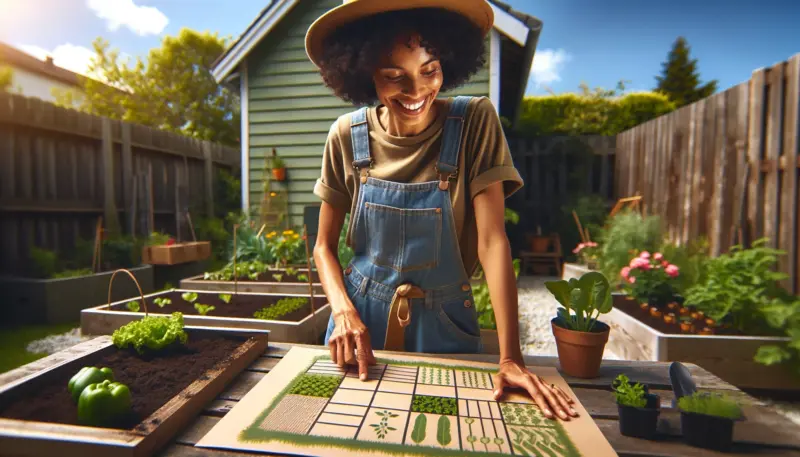
what is square foot gardening?
Square foot gardening (SFG) is a way to grow plants in a square-shaped box. The box has a grid inside and is 4 feet by 4 feet (1.2 meters by 1.2 meters) in size and 12 inches deep.
The inner box is then divided into 16 smaller squares using materials like wooden boards or aluminum wires.
Which was introduced by an American author and TV presenter, Mel Bartholomew, introduced this concept to the public in the 1981s and also, through his book Rodale, Inc.
With square foot gardening, you can grow a wide range of plant varieties from vegetables to herbs and flowers in your small backyard, a patio, or even on a balcony is possible. It is the best alternative for people with limited space or a good beginning solution.
Benefits of Square Foot Gardening
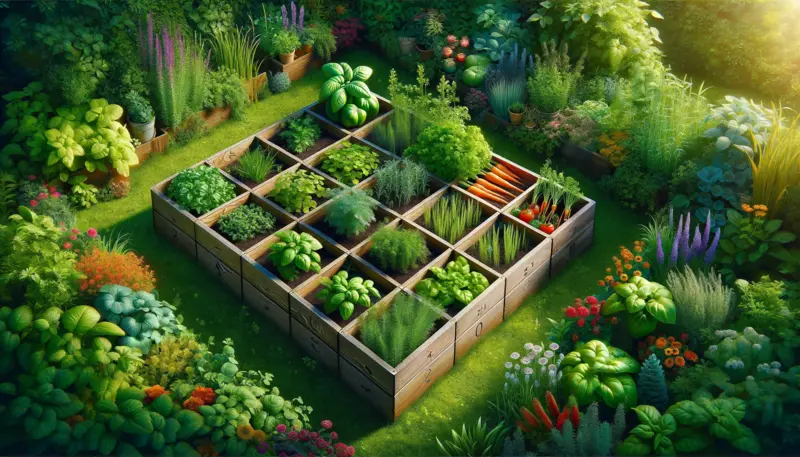
Plants can be organized and grown smartly in a square foot gardening approach with an orderly space grid. Think of a garden where every square foot is a mini plot of herbs, vegetables, and flowers.
It has numerous advantages, especially for starters, and this is another reason they should consider it as an option to get maximum utilization of available space. This means we now look at some of the main benefits.
Efficient Use of Space
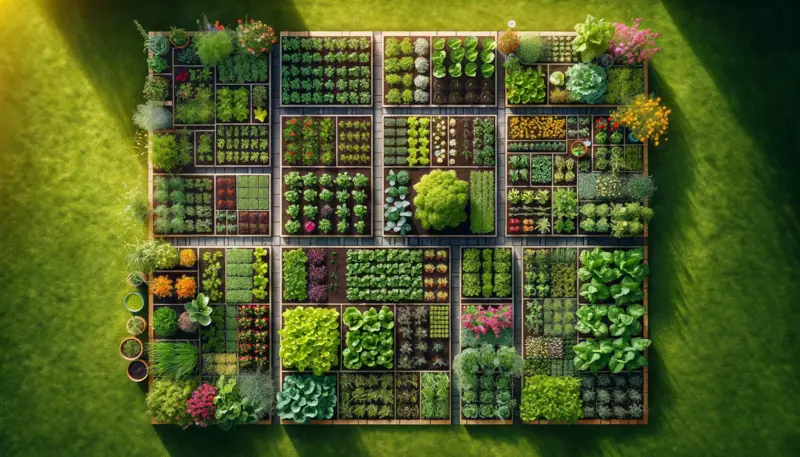
Every inch matter in Square Foot Gardening planner. This method becomes beneficial for people with limited garden spaces. You can also use each inch by dividing your garden into one-foot squares and then planning each square.
The spatial organization is not only about placing all the plants into the limited space available but also assigning reasonable and necessary amounts of areas for other different plants.
Increased Yield
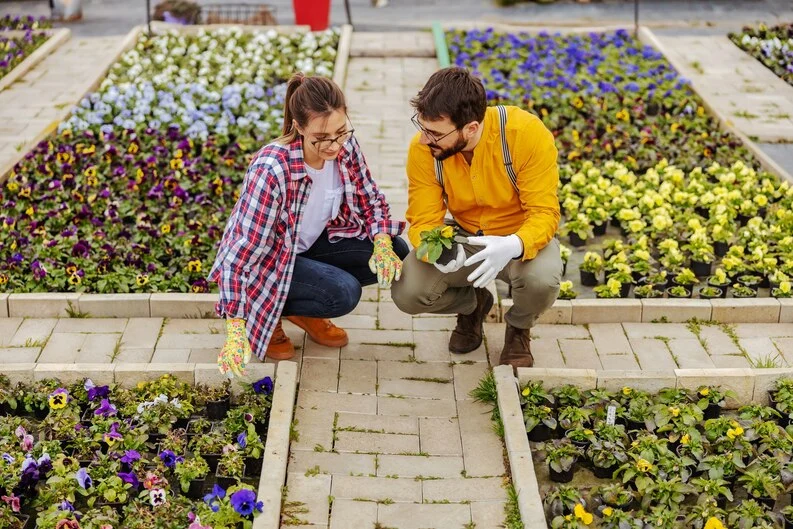
The square foot garden has one of the most notable advantages of a higher yield. This approach enables one to produce many plants in a small place instead of traditional row gardening.
This close spacing causes less waste on seed and reduces competition among plants for available resources. Therefore, every square foot of your garden works double for you, resulting in a higher yield per unit area.
Reduced Pests and Diseases
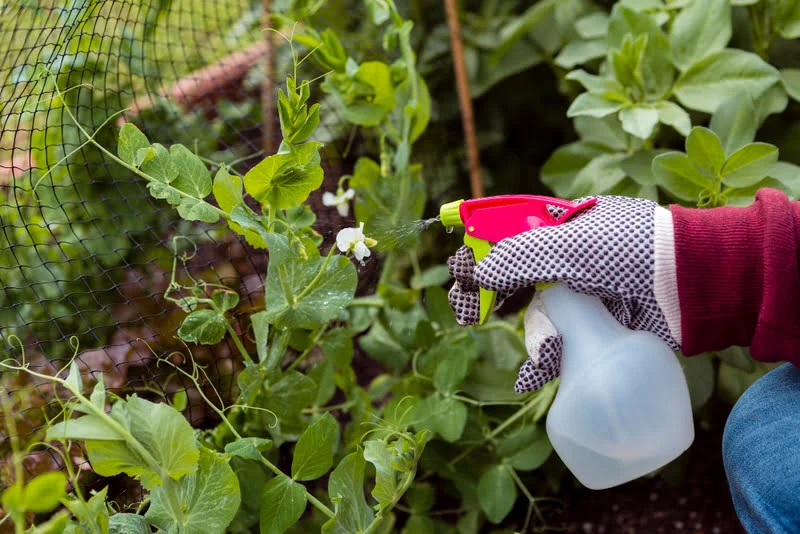
Moreover, as we have seen, square-foot gardening leads to healthy plants. Spatial distance between every square may restrict the spreading of pests and diseases from one court to another.
Such problems may arise quickly when plants are clustered into tight spaces. Apart from this, it helps in increasing biodiversity; through growing different types of planting in the same field, you quickly eliminate any one predator that could ultimately destroy all your products at once.
Easy to Maintain

Square Foot Gardening makes it easier to perform gardening maintenance. This technique reduces the time required for weeding, watering, and attending plants.
Finding and fixing problems becomes easy as they are assigned appropriate positions for every plant. Furthermore, as it involves a small area, watering and harvesting become easy and take less time.
SFG is an easy, sensible method for growing plants. Which saves the space, increases the yield, minimizes the chances of pests/disease, and eases maintenance.
These advantages are good starting points for a beginner and people with limited space, allowing them to have a profitable and fun-filled gardening experience. Let’s see how we can maximize your yield.
How a Square Foot Gardening Planner Can Maximize Your Harvest
Optimizing Plant Placement for Maximum Sunlight and Airflow
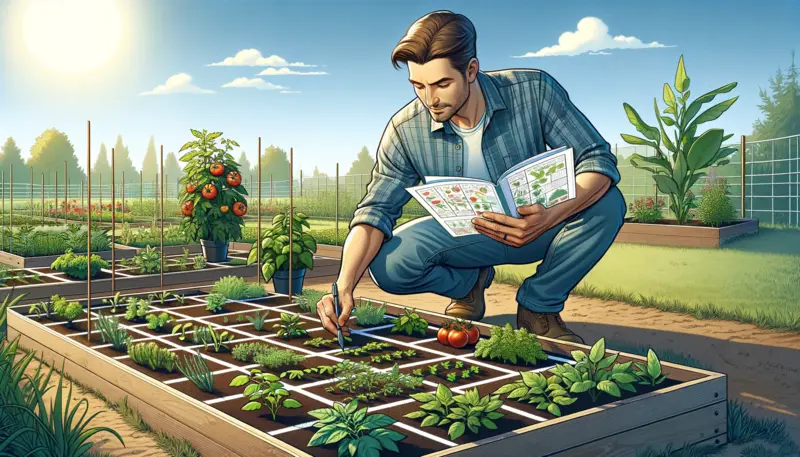
Your garden will thank you for investing in a square foot gardening planner, which is not more than simply a tool. Understanding the importance of light and air to plant health can be a game-changer for beginning gardeners.
A garden designer will help you arrange your plants in a square foot garden bed to get the optimal amount of water, sunlight, and airflow.
Plants that grow quickly, like vining tomatoes, should be placed on the north side of the garden so that they don’t cast too much shade on the other plants.
The risk of fungal diseases can also be reduced by properly spacing plants within each square to allow for sufficient airflow. It’s like a chess game with nature, where every move is calculated for the best outcome.
Planning for Succession Planting and Crop Rotation
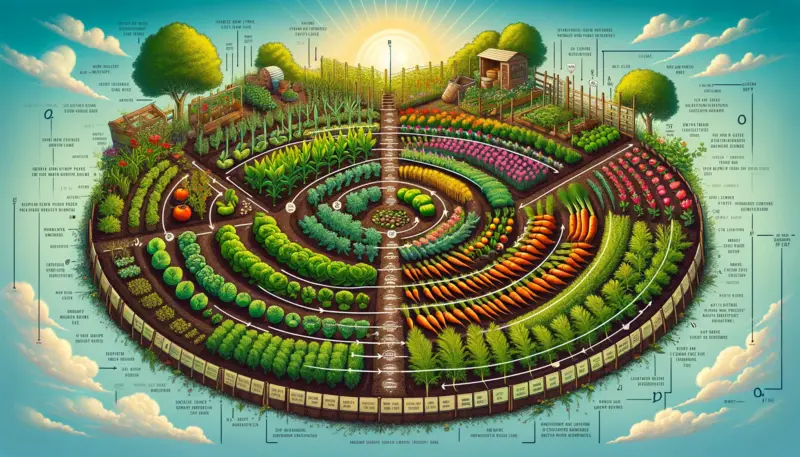
If you want your garden to be consistently beneficial you need to implement strategies like succession planting and crop rotation; this is where your square foot gardening planner comes in handy.
Planting seeds at staggered intervals ensures that not all crops will mature at once. Please think of how nice it would be to have a steady supply of lettuce and radishes all season.
However, crop rotation requires periodic switching up of what’s planted in each individual plot. This method is useful for preventing the spread of illness and preserving the fertility of the soil.
With the help of a planner, you may lay out these rotations and successions to guarantee a steady healthy harvest.
Tracking Plant Growth and Development
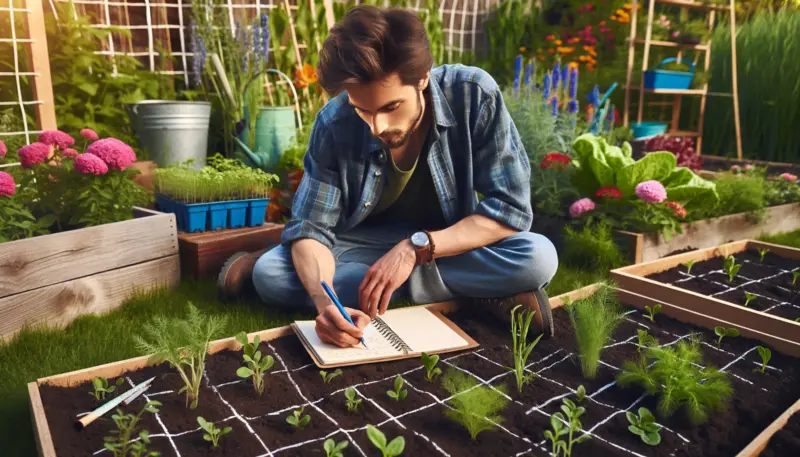
Keeping track of every individual plant in your square foot garden is essential. Your gardening planner might be a logbook for each plant’s growth and development. For beginner gardeners, this sort of record-keeping is crucial because it teaches you to see patterns in plant development.
You can keep track of when seeds germinate, how plants develop, and when they are ready to be harvested. Keeping accurate records of your garden’s development is like playing a detective game.
Monitoring Pest and Disease Pressure
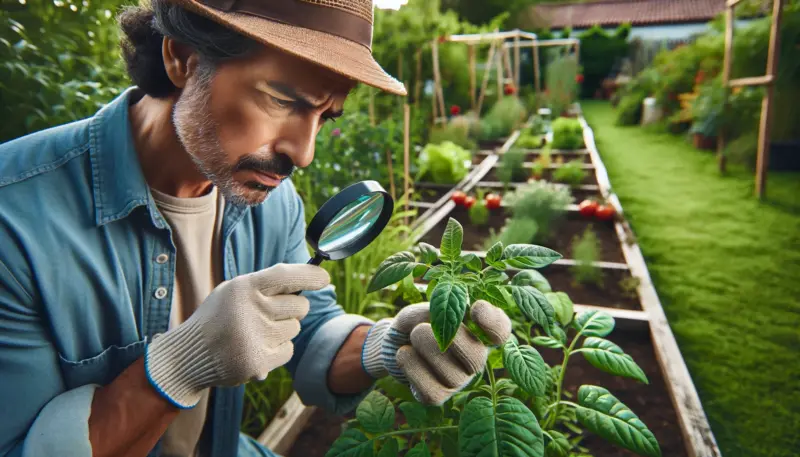
Keeping a planner in which, you regularly record observations of pests and diseases can help you spot problems before they develop. Unusual leaf spots or the frequent occurrence of a certain insect are two examples.
When problems are identified early, it’s easier to take simple procedures or preventative measures. Imagine your planner as a watchful guard who ensures the well-being of your garden at all times.
I have included some of the best working tips for increasing the maximum SFG yield. If you want more knowledge, read the Square for gardening books or the headings below. You will understand what the Essentials are required for SFG.
Essentials of Square Foot Gardening Planner
Importance of Planning
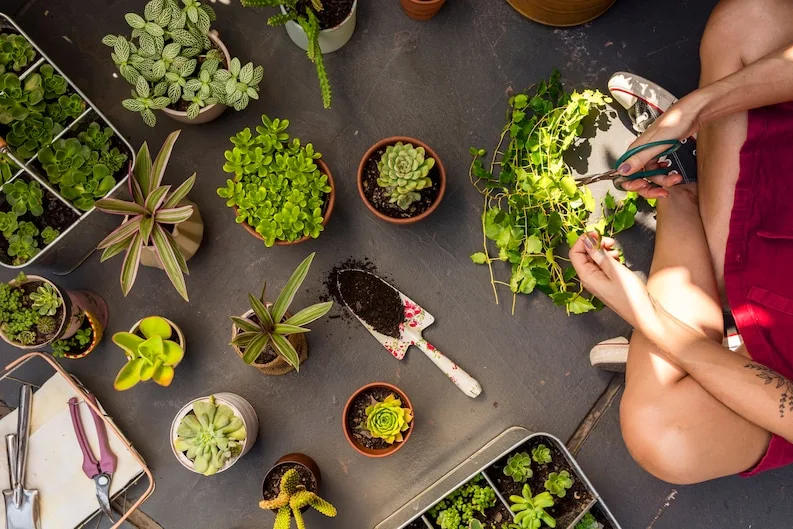
Square foot gardening is quite like sailing without a plan. Especially for new gardeners, preparation is the key to a productive square foot garden. It’s about identifying your garden’s requirements and preparing things to fix them.
A well-thought-out strategy may cover everything from what to plant and where to crop maintenance and harvesting. That’s why Consider it as your road map to success.
Always preparation is the key to a stress-free and rewarding gardening experience. Imagine knowing precisely what you’ll do in your garden daily rather than guessing and hoping for the best. That’s the power of planning in square foot gardening.
Key Components of a Successful Square Foot Garden Plan
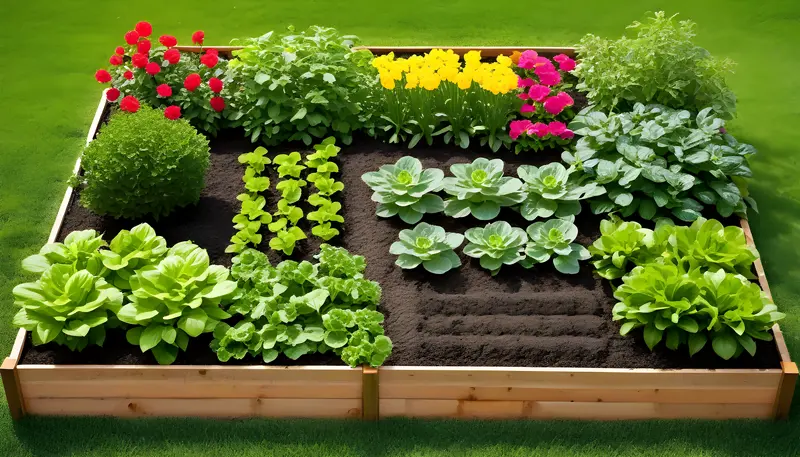
So, what makes a square foot garden plan successful? Here are the key components:
- Garden Layout: Start with a sketch of your square foot garden bed. Divide it into foot squares – each square is a new opportunity. This visual representation is crucial for organizing your space and envisioning your garden’s potential.
- Plant Selection: Choosing the right plants is like casting characters for a play. You want a harmonious blend where each plant plays its role well. Consider factors like sunlight requirements, growth habits, and companion planting.
This is where you can use your knowledge about plants per square, crop rotation, and traditional rowed versus square foot gardening methods. - Soil Preparation: Your garden’s foundation is its soil. A mix of peat moss, compost, and vermiculite, typically recommended for square foot gardens, offers a rich and well-draining base. Remember, healthy soil equals healthy plants.
- Scheduling: Timing is everything in gardening. Plan when to plant and when to harvest. Utilize techniques like succession planting for a continual supply of vegetables. A square foot gardening planner can be a great tool to keep track of these timelines.
- Maintenance Strategy: Regular maintenance keeps your garden in top shape. Plan for routine tasks like watering, weeding, and checking for pests. Efficient watering practices and easy maintenance are hallmarks of square foot gardening.
- Pest and Disease Management: Be proactive about pests and diseases. Incorporate preventive measures and natural remedies in your plan. Regular monitoring helps you act swiftly if issues arise.
- Resources and Tools: Know what tools and resources you’ll need. From simple gardening tools to a digital square foot gardening planner, having the right equipment makes gardening smoother and more enjoyable.
You have understood the importance of a planner and its key components. Now, we will explore how to choose suitable locations and how to design layouts.
Choosing the Right Location and Layout
Factors to Consider for Optimal Location

Selecting the perfect spot for your square foot garden is a bit like real estate – it’s all about location, location, location! For beginner gardeners, this choice can make a huge difference. Here are the key factors to consider:
- Sunlight: Most vegetables crave sunlight. Look for a spot with at least 6 to 8 hours of direct sunlight daily. Observe your potential garden area throughout the day to see how the sun moves across it.
- Water Access: Your garden needs to stay hydrated. Ensure your chosen location is near a water source. Dragging a hose across the yard or carrying water can be difficult.
- Protection from Elements: Consider natural windbreakers or structures that protect your garden from strong winds or heavy rain. However, make sure these don’t block the sunlight.
- Soil Drainage: Good drainage is crucial. Even with raised beds, you want to avoid areas where water accumulates after rain. This can lead to root decay and other issues.
- Ease of Access: Ensure your garden is easy to reach for regular maintenance. You don’t want it to be out of sight and out of mind.
Designing the Layout Using a Square Foot Gardening Planner
Now, let’s talk layout. The art of gardening in a square foot plot lies in its design. Plan your garden by drawing its outline on paper and dividing each square into 1 square foot. Here’s how to approach it:
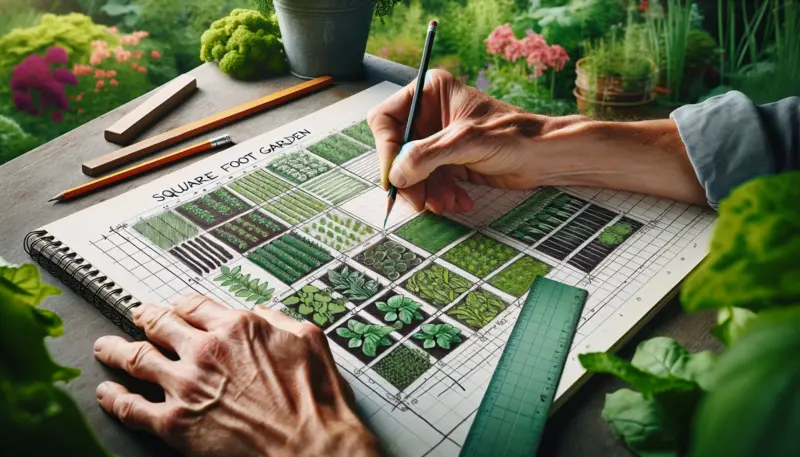
- Visualize the Space: Draw your garden bed on the planner. Visualize how it will look. Each square is a canvas for your plants.
- Decide on the Number of Squares: This will depend on the size of your garden bed. A standard size is 4 feet by 4 feet, which gives you 16 squares to work with.
- Allocate Plants per Square: Based on your research or guidelines from a square foot gardening guide, decide how many plants will go into each square. For example, you can plant 16 carrots in one yard but only one tomato plant in another.
- Consider Growth Direction: Plan for taller plants to be on the north side of the garden to avoid shading smaller plants. Also, consider how plants like vining plants will grow and ensure they have enough space.
- Plan for Accessibility: Leave pathways or ensure you can easily reach each square without stepping on the soil to avoid compaction.
- Rotation and Succession: Think ahead about rotating crops and succession planting to keep your soil healthy and your garden productive throughout the seasons.
Keep in mind that the right location and designed layout are critical. It’s the first rule for building a successful SFG. Also, learn the best mixture of soil and the best organic or artificial fertilizer by exploring down.
Soil and Fertilization Tips for Square Foot Gardens
Best Soil Mixtures for High Yield
The secret to a successful square-foot garden is in the soil. If you’re just getting started in gardening, you just need to know that not all soils are the same.
The most excellent soil mixture for a square-foot garden is one that encourages healthy development and large yields. What you must know is as follows.
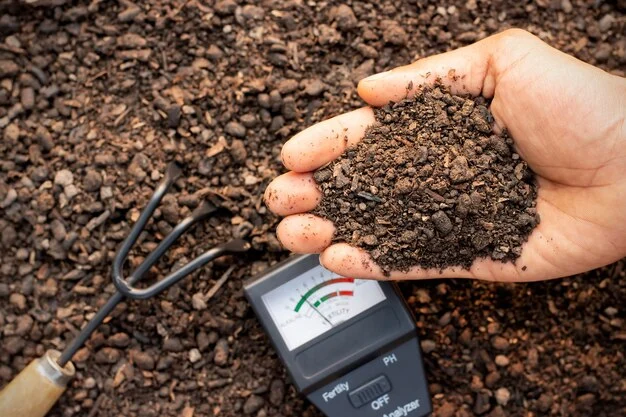
- Ideal Soil Composition: Mel Bartholomew’s mix is a popular recipe for square foot gardening soil: 1/3 peat moss, 1/3 vermiculite, and 1/3 compost. This combination provides a light, fluffy, nutrient-rich environment for your plants.
The peat moss retains moisture, vermiculite aids in aeration and drainage, and compost offers a wealth of nutrients. - DIY or Store-Bought: Make your own or purchase pre-mixed soil suited for raised beds. If you’re going to make your own, use a variety of organic materials such as:
(Nitrogen Sources: vegetable peels, coffee grounds, tea bags, fresh grass clippings, and green leaves).
(Carbon Sources: dry leaves, straw, wood chips, sawdust pellets, shredded paper, and cardboard) for the compost component. - Depth Matters: The recommended depth of 12 inches in square foot gardening is ideal. This depth supports a wide range of vegetables and allows roots to grow freely, contributing to healthier, more productive plants.
- Refreshing Soil: Renew your soil at the change of each season. Add more compost to replenish nutrients. This is especially crucial in a square foot garden, where plants are grown closely together and can deplete the soil faster.
Organic Fertilization Techniques for Square Foot Gardening
Fertilization is the key to maintaining a flourishing square foot garden, and organic methods can yield fantastic results. Here’s how to do it right:
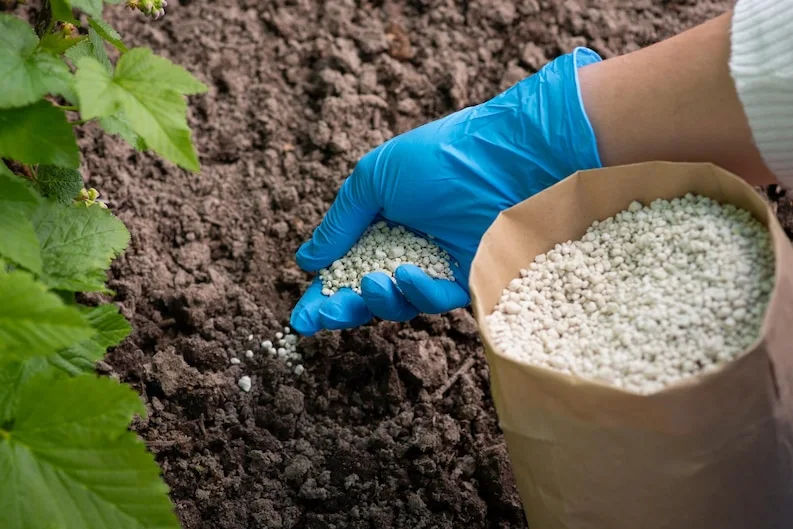
- Compost is King: If you want to naturally fertilize your garden, using compost on a regular basis is one of the best ways you can do this. It delays the release of nutrients into the soil, retains water, and promotes healthy plant development.
- Cover Crops: Planting cover crops in your off-season squares, such as clover or buckwheat, will help your soil retain more water and nutrients. They add organic matter and nutrients when tilled back into the soil.
- Synthetic vs. Organic Fertilizers: Use organic fertilizers like fish emulsion, bone meal, or seaweed extracts to boost your plants. Unlike synthetic fertilizers, which contain harmful chemicals, organic fertilizers are safe for food crops.
- Mulching: Using organic mulch, such as straw or grass clippings, not only prevents weeds but also enriches the soil with nutrients as it decomposes.
- Regular testing: Keep a regular testing schedule to monitor your soil’s condition. The results of the few soil tests will tell you exactly what your garden requires, and you can then adapt your fertilization methods according to it.
The best soil mixture and natural fertilizer are the combination for successful gardening, and choosing the right plant and spacing is also important. Now, let us understand the strategies.
Plant Selection and Spacing Strategies for Square Foot Gardens
The success of a square foot garden relies on careful plant selection and strategic placement. These choices may seem overwhelming at first, but with a few tips in mind, you’ll have a flourishing garden in no time.
How to Choose Plant
First, it’s essential to select plants that grow well according to your area’s climate conditions. This increases the likelihood of a healthy, productive garden.
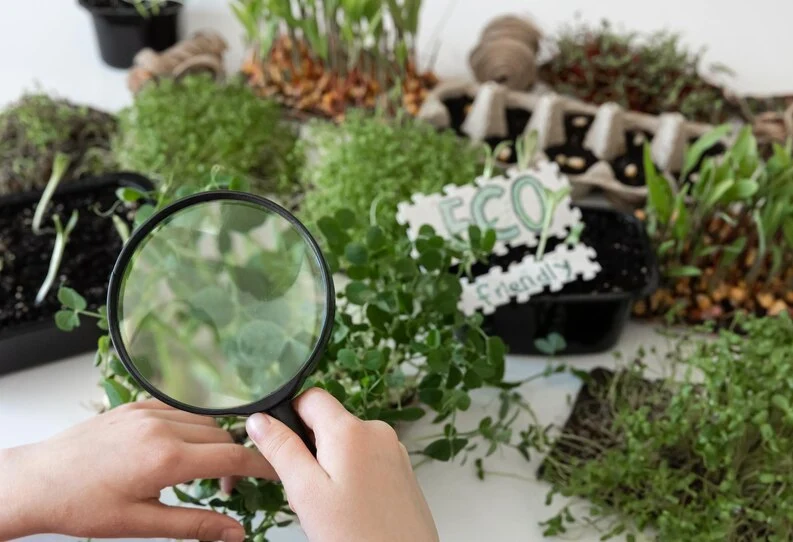
- Imagine the Sunlight: It’s important to consider how much sun your garden gets. Determine whether full sun, partial shade, or complete darkness will be present, then do some research on whether the plants will grow in those conditions.
- Mix It Up: diversity is your friend. A mix of vegetables, herbs, and flowers can create a balanced ecosystem, reducing the risk of pests and diseases.
- Personal Preferences Matter: Grow what you love to eat! Nothing beats the satisfaction of your hard work, which pays off with a bountiful harvest.
Effective Spacing Using the SFG Method:
In a garden planner spacing is key. It’s all about getting the most out of every square inch. Here’s how to do it right:

- Follow the Square Foot Guidelines: In SFG, plants are arranged in grids. For example, one square foot might be a house of one tomato plant, four lettuce, or sixteen radishes.
- Vertical Growing: Using vertical structures to grow space-saving climbing plants, such as cucumbers and beans. This gives your yard a decorative touch in addition to saving space.
- Leave Room to Grow: Giving your plants enough space for growth can result in more nutritious, healthier plants despite the temptation of stuffing as many as possible into your space. Overcrowding can lead to competition for nutrients and increased disease susceptibility.
Have understood the importance of plant selection and saving space. Now, let’s dive deeply to see how to pour water on plants and maintain them effectively.
Watering and Maintenance Techniques
Maintaining a healthy square-foot garden requires regular watering and maintenance. This method will not only help your plants grow healthy, but also, they will save time and money. Let’s look at some helpful tips for beginning gardeners so that they get a handle on the essential tasks.
Efficient Watering Practices
Watering your SFG is more than how much volume we pour and more about how consistently we pour and efficiency. Here are some tips to ensure your garden gets just the right amount of water:

- Water Deeply, But Less Often: Instead of frequently watering on the surface, water deeply inside the plant to promote strong root growth. Depending on the weather and the soil type, deep watering once or twice a week should be sufficient.
- Morning Watering: You should water your garden every morning. As a result, plants store the water by absorbing it before the day’s heat sets in.
- Use a Drip Irrigation System: Drip irrigation feeds water straight to the plant roots, minimizing waste and preventing leaf diseases caused by moist foliage.
- Mulch to Retain Moisture: Applying a layer of organic mulch around your plants can aid the soil in retaining moisture and reducing the need for frequent watering.
- Check Soil Moisture: Verify the soil’s moisture level by digging a small hole with your finger for a few inches below the surface before you water. If the ground is still moist, you can put off watering for another day.
Routine Maintenance Tips Using a Square Foot Gardening Planner
It is not just for planning but also for maintaining your garden. Here’s how you can use it to keep your garden in top shape:
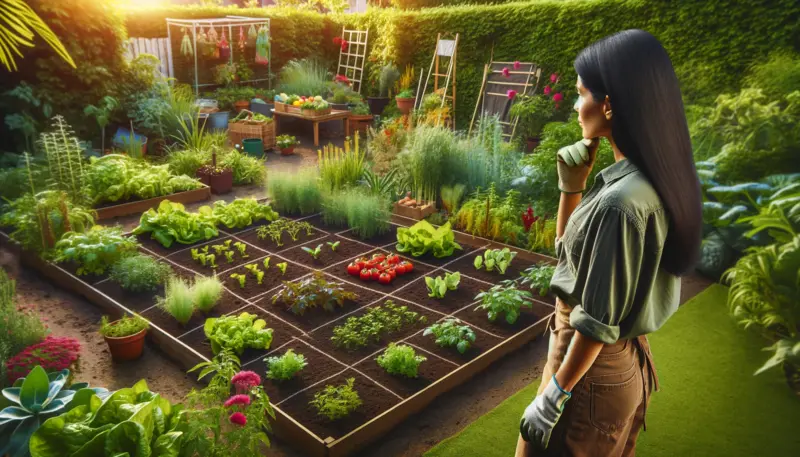
- Track Watering and Fertilizing: Use your calendar to keep track of when you water and when you apply fertilizer. This helps ensure you’re not over or under-doing either.
- Weekly Check-ups: Conduct regular weekly inspections of your garden. Check for pests, illnesses, and nutritional deficiency symptoms and take steps to fix them as soon as possible.
- Prune and Harvest Regularly: Pruning and harvesting at regular intervals promotes growth and prevents the spread of disease. Your planner can help you track the best times for these tasks.
- Weed Control: Weeding should be done in short, frequent intervals rather than waiting for weeds to take over the garden and then trying to deal with them all at once.
- End-of-Season Cleanup: Clean up your garden at the end of the growing season and add old plant debris to your compost pile. This helps prevent disease carryover to the next season.
These are the practical tips for watering and maintaining your plant. Now, let’s understand how to control the pests and diseases in the SGF planner.
Pest and Disease Control in Square Foot Gardening
Preventing pests and diseases is essential to keeping your square foot garden flourishing. A successful garden depends on the gardener’s ability to handle the issues that may spoil a beginner gardener’s efforts.
So, listen carefully; the most common garden pests and diseases can be easily avoided if you know how to spot and eliminate them.
Identifying and Managing Common Pests and Diseases
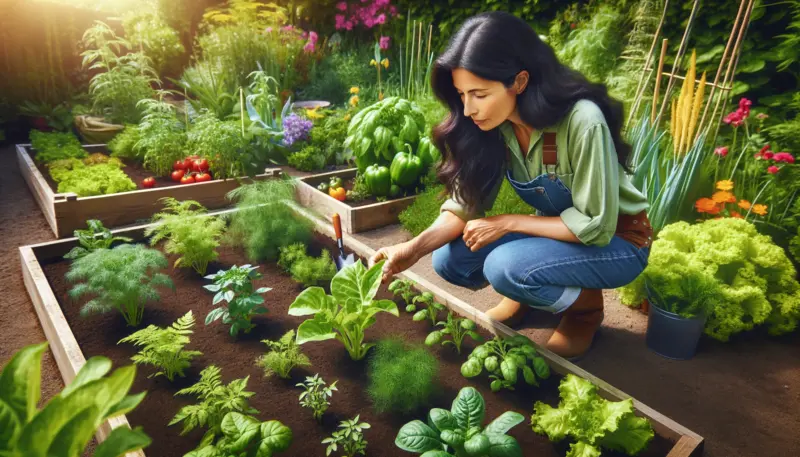
- Regular Inspection: Inspect your plants regularly to look for any signs of injury by pests or diseases by Looking under the leaves, near the stem, and even in the soil. Always early detection is the key.
- Identify the Culprit: Learn to identify common garden pests and diseases. For example, holes in leaves could indicate caterpillars, while yellowing leaves might suggest a fungal issue.
- Manual Removal: Sometimes, the best method is the simplest one. If you see any bugs around the plant, pick them up by hand or clean them with a force stream of water.
- Natural Pesticides: Use natural pesticides like neem oil or insecticidal soap for severe infestations. These are less harmful to the environment and beneficial insects.
- Disease Control: To prevent the spread of disease, cut off the infected parts of plants and throw them away. Also, Improve the air circulation around the plants and avoid watering foliage to reduce the risk of fungal diseases.
Preventative Measures and Natural Remedies
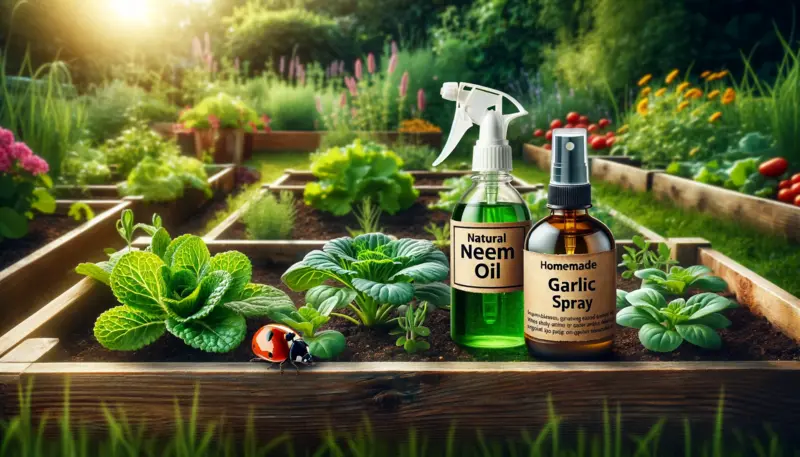
- Healthy Soil: A well-balanced nutrient mixture of soil can reduce the chances of pest and disease formation.
- Companion Planting: When Some plants are planted together with other plants, they can protect each other from insects. For example, planting marigolds can help deter nematodes and other pests.
- Crop Rotation: To avoid forming soil-borne diseases and pests, rotating your crops for each season is always recommended.
- Beneficial insects: insects such as ladybugs and bees can help you keep the pests away and pollinate your plants, so it’s a good idea to attract insects.
- DIY Remedies: Try homemade solutions, such as a spray prepared from diluted dish soap and water, which can be effective against soft-bodied pests.
The health and productivity of plants in your square-foot garden can be protected using these methods. Keep in mind that maintaining a healthy garden requires regular care.
Next, we’ll discuss how to harvests and get maximum yield from your square foot garden by sharing advanced tips and techniques for a bountiful harvest.
Harvesting and Maximizing Yield in Square Foot Gardening Planner.
Tips for Timely and Effective Harvesting:
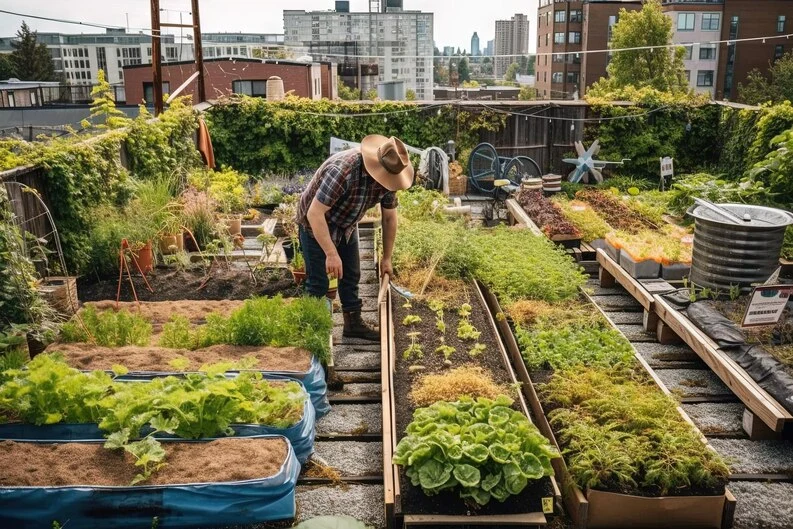
- Know When to Harvest: Each type of vegetable has its own sign that shows it’s ready to be harvested. For example, tomatoes are readily picked when they are firm and have developed their full color.
- Harvest Regularly: Always frequently harvest it encourages more production. For example, picking beans and peas often can lead to a more extended harvest period.
- Use the Right Tools: Sharp scissors or pruning shears are helpful in harvesting without causing any injury to the plant. Also, have a little fork, which is useful in loosening the soil around root crops.
- Harvest in the Morning: If possible, harvest in the morning when the temperatures are cooler. As a result, your yield will last longer.
- Handle with Care: Rough handling might cause your harvest to spoil quickly, so be mindful when harvesting.
Techniques to Increase Yield in SFG:
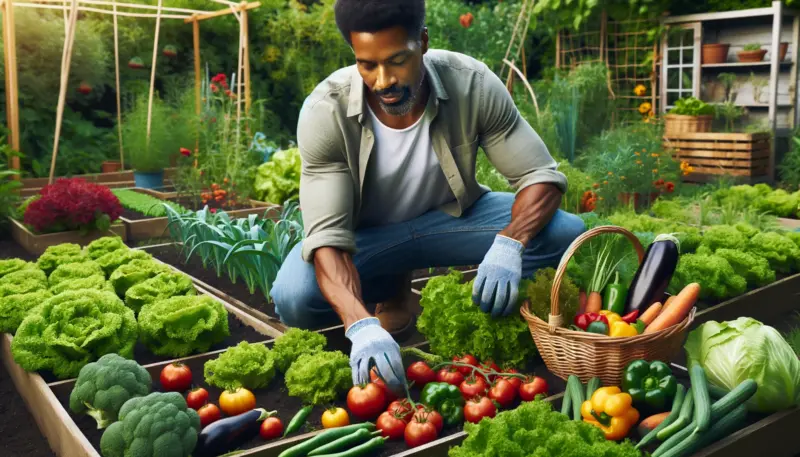
- Succession Planting: It refers to the cultivation of a new crop following the harvest of an old crop. It ensures that your garden is always busy harvesting during the growing period.
- Vertical Gardening: These vining plants, like cucumbers and tomatoes, should be supported using a trellis or cage to grow vertically. This enhances productivity and saves available space.
- Optimal Plant Spacing: Plants should be placed according to the square foot gardening guidelines to ensure optimal plants grow as desired without blocking one another.
- Regular Feeding and Watering: Ensure you feed and water your plants regularly. Consistently caring for plants assures health and productivity.
- Encourage Pollinators: Add pollinators by planting what bees and butterflies like. With them, fruit and vegetable farms can operate.
Upcoming tools section are the important resources for a successful gardening quickly check it out.
Tools and Resources for Square Foot Gardening Planning
Recommended Tools and Resources for Effective Planning
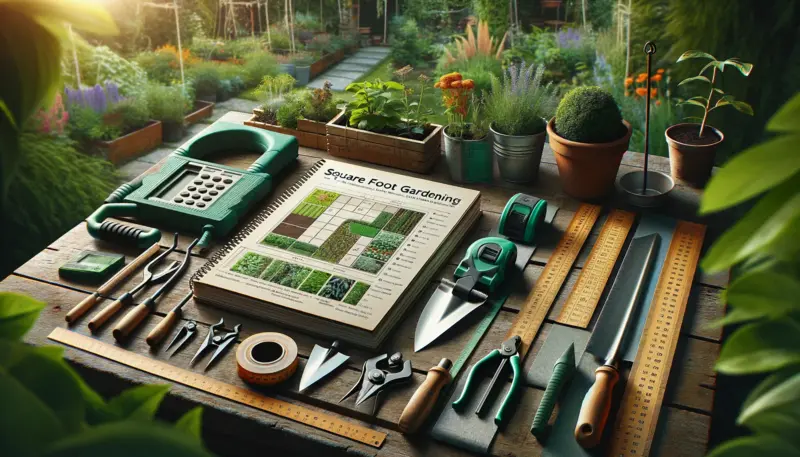
- Square Foot Gardening Planner: If you want to keep track of when you planted seeds, picked them, and how your plants developed over time, you’ll need a planner or garden journal.
- Measuring Tools: A measuring tape, or a yardstick is helpful in accurately laying out a square-foot grid for your garden beds.
- Garden Trowel and Spade: You can only plant or transplant something in your square-foot garden with a trowel and spade.
- Pruners or Scissors: These are essential for caring for plants and cutting down waste during harvest.
- Soil Testing Kit: You can learn about your soil’s nutrient and pH levels using a soil testing kit and make the appropriate changes.
- Watering Can or Hose: A watering can with a long spout or a hose with a gentle spray setting is ideal for watering your plants without disturbing the soil.
- Gardening Gloves: To protect your hands while working in the garden.
- Reference Books and Guides: Books focused on square foot gardening are a fantastic resource for beginner gardeners because they include much information, like our website. So, reading gardening-related books is recommended.
Using Digital Square Foot Gardening Planners and Apps
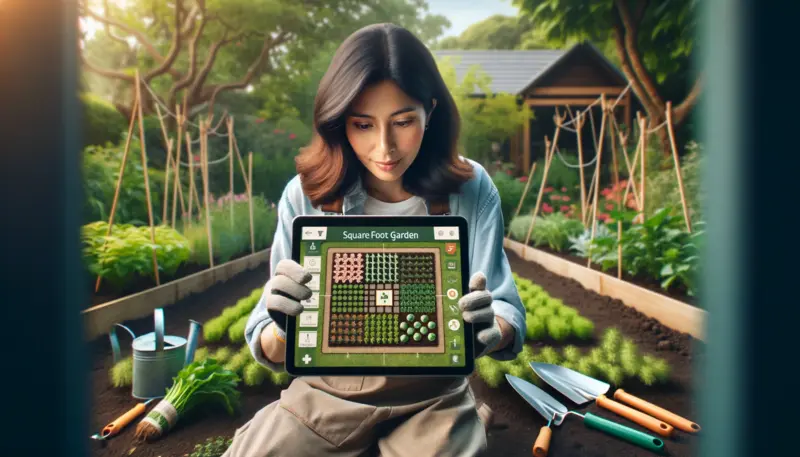
- Digital SFG Planners and Apps: There are several digital Square Foot Gardening Planners websites and apps on the internet that may assist you with your garden design, allow you to monitor your plants’ development, and serve as a reminder for regular watering and maintenance schedules.
- Online Communities: Participate in online gardening communities like message boards or social media groups. So that you access a lot of information and support from other gardeners.
- Gardening Blogs and Websites: Beginners may get false information from fake websites, so it’s essential to ensure that the information you’re reading is accurate. Find reliable blogs that provide helpful tips, guides, and creative ideas for your square foot garden.
- Interactive Tools: Some websites offer interactive tools that help you visualize your garden layout, select plants, and plan your planting schedule.
Conclusion:
Square foot gardening provides one of the easiest methods of growing different types of fruits, vegetables, and flows in a smaller space. You can have a larger harvest if you only divide your garden into small squares, making for easier garden maintenance.
Besides, this approach assists in the adoption of environmentally friendly habits. Organize your garden from seed to harvest with a Gardening Planner.
Beginner gardeners must spend their time mastering the SFG garden before they can experiment with new methods.
At last, squire foot gardening is a gateway to better health and happiness regardless of location. Have fun with gardening!
FAQ
What is Square Foot Gardening?
Square foot gardening (SFG) is a way to grow plants in a square-shaped box. The box has a grid inside and is 4 feet by 4 feet (1.2 meters by 1.2 meters) in size and 12 inches deep. The inner box is then divided into 16 smaller squares using materials like wooden boards or aluminum wires.
What Kind of Soil Should I Use for My Square Foot Garden?
Use a Mix combination of compost, peat moss, and either vermiculite or perlite. This mixture provides excellent drainage, good air circulation, and rich nutrients. If you are planning to do square foot gardening, potting soil may not offer ideal conditions.
What grows best in a square-foot garden?
Large plants:
Brassicas: Cabbage, broccoli, Brussels sprouts, and cauliflower.
Herbs: Coriander, rosemary, oregano, sage, and mint.
Others: Eggplant, pepper, tomato, capsicum, and okra.
Four plants per square foot: green beans, Peas, Swiss chard, Lettuce, and Annual herbs.
Nine plants per square foot: Onions, Spinach, Beets.
How Many Plants Can I Grow in One Square Foot?
The number of plants per square foot varies based on the plant’s size. For example, you can plant one tomato plant per square, four lettuce plants, nine spinach plants, or sixteen radishes. The square foot gardening method provides guidelines for various plants.
Do I Need to Rotate Crops in a Square Foot Garden?
Yes, crop rotation is beneficial even in a square foot garden. It helps prevent soil-borne diseases and nutrient depletion. Try not to plant the same family of crops in the same square for at least a couple of years.
Can I Practice Organic Gardening with Square Foot Gardening?
Absolutely! Organic gardens are quite compatible with square foot gardening. Go for organic soil mixes, compost, and natural pest control methods. It also encourages natural, organic, and friendly environmental products.
Can I Use Square Foot Gardening on a Balcony or Patio?
Square foot gardening is suitable for balconies and patios. Your garden can either be raised beds or contain any plant. Simply make sure that the space is bright enough and can handle an entire garden.

Leave a Reply